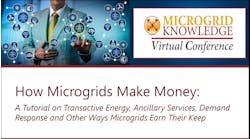When CleanSpark began talking to owners of luxury homes in California, it pitched microgrids as it usually did with economics as a key part of the discussion.
But the company soon found that these microgrid customers, unlike most others, weren’t keenly interested in return on investment.
“These are people that don’t care about payback; they just want resilience,” said Zach Bradford, CEO of CleanSpark, which focuses on microgrid controllers and software. “It requires a change in how you’re speaking to the customer.”
Welcome to California in the age of public safety power shutoffs where even mansion owners face grid insecurity.
By CleanSpark’s calculation, California has thousands of luxury homes over 10,000 square feet, making it a market to pursue because power outages related to wildfires don’t seem to be going away anytime soon. A Pacific Gas & Electric executive projected that the state’s electric system may not be back to normal until the end of the decade. Adding to their need for reliable power, some of the properties also double as business locations with outbuildings or equipment on the premises, Bradford said.
CleanSpark is also attracted to the market because luxury homeowners seem to be open to innovative technologies. They’re not necessarily looking for the familiar Tesla battery but want to know what’s new and cutting edge, Bradford said. A microgrid project for a 14,000 square-foot home that CleanSpark announced last week offers a good example. It includes a supercapacitor energy storage system, an emerging alternative to traditional batteries. Provided by Kilowatt Labs, the supercapacitor, along with solar panels, will power the construction of the estate. Additional solar and standby generators will be added later for when the homeowners move in.
CleanSpark and solar installer Bay Area Energy Solutions are working in partnership on the home, which is located in Healdsburg, California. The microgrid will have no ties to an electric utility. The homeowner chose to be completely off-grid because the estate is in a remote, fire-prone area. Utilities have, at times, shut off power in such areas to avoid creating sparks from the transmission of electricity over wires.
Microgrid for Healdsburg, California, Estate
Phase 1 (for construction) will include:
- 56.8 kWh or 16 3.55 kWh supercapacitor modules
- Solar will be 30kW DC
- Controlled by CleanSpark’s mPulse controls software platform
Phase 2 will result in a total of:
- 113.6 kWh supercapacitor modules
- Solar will be 72.9 kW DC
- A backup generator (the generator has not been selected yet)
- Controlled by CleanSpark’s mPulse controls software platform
While power-outage prone California offers a ripe market for microgrids, CleanSpark sees potential elsewhere, too, and is forming partnerships with contractors in states with no major electric reliability problems or financial incentives for resilience.
According to Bradford, the potential customer in these states is a homeowner who says, “Hey, I really want to focus on green energy, and I’m going to spend more money than maybe would make sense to do so because I’m in the Midwest and my power comes from coal.”
From luxury homes in California to data centers in Georgia
Even as it moves into the high-end home market, CleanSpark continues to focus primarily on commercial and industrial customers, where it’s also exploring innovation by way of a data center facility it acquired in December, one of three company acquisitions last year.
Called ATL Data Centers, the Atlanta, Georgia, facility creates a “tremendous playground” for the company to test advances in its microgrid control technology, Bradford said.
The data center encompasses two operations: One offers traditional data hosting; the other serves Bitcoin mining. CleanSpark intends to add microgrids to the facility and expand it from 20 MW to 50 MW.
“We’re really looking to use the data center and the energy load as a public testbed,” he said. “We’re going to put multiple microgrids on-site that will interlink and work together.”
Some of the microgrids will have dedicated missions, such as cost reduction or maximizing green energy use. A dashboard will showcase how well they perform.
The property is particularly well-suited for experimentation because it sits on the dividing line between two utility territories: One is a municipal utility, and the other is a traditional investor-owned utility. Each has a different kind of agreement with the data center. Each has a different kind of agreement with the data center, opening up the opportunity for CleanSpark to work with both flat rate and variable pricing arrangements. CleanSpark intends to demonstrate how microgrids can bring benefits under both scenarios.
Making flat load look variable
The data center also offers CleanSpark the ability to “play” in an area that has captured the company’s attention: the ability to optimize flat load with microgrids and building management systems. Doing this requires an in-depth understanding of an operation beyond its energy systems, so it requires partnerships with specialists in the industry.
For example, Bradford described how the flat load of a refrigeration system might be managed as a variable load to take advantage of energy price changes. This involves lowering temperatures and super freezing a product, then letting the temperature rise back up at an optimal time.
Analogous operations may be undertaken at data centers, which also tend to produce flat power loads. “There’s not a lot that you can normally do besides add resiliency, right? That’s kind of where people have focused on data centers — downtime. But there are other ways, we believe, you can make an impact. But you have to get into the finer-tuned details,” he said. “It should be fun to figure it out.”
2021: A big year for microgrids
Tackling microgrid innovation that spans from homes to data centers and from East Coast to West Coast, Bradford heads into 2021 with optimism. It’s a mood buoyed by a 122% rise in company revenue in 2020 and a new U.S. president who promises to make green energy a priority.
“I expect that the microgrid market and green energy, in general, is going to get a big boost in the next year,” he said. “With COVID, a lot of projects got put on hold, and our expectation is a lot of those are coming off hold in the next year.”
It’s all good news for CleanSpark.
“We’re moving and shaking. We’re well-positioned. We’re actually, luckily, well-capitalized, and we’re searching for opportunities,” Bradford said.
Track microgrid news by subscribing to the free Microgrid Knowledge Newsletter.







